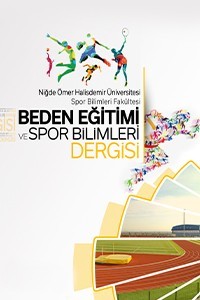9-10 YAŞ GRUBU TENIS OYUNCULARINDA MOTOR PERFORMANS TESTLERDE YAŞ VE CINSIYET FARKLILIKLARININ VE YÜZDELİK VERİLERİN BELİRLENMESİ
Yaş ve cinsiyet farklılıkları, tenis, motor performans, yüzdelik veri
PERCENTILE NORMS AND AGE AND GENDER DIFFERENCES IN THE MOTOR PERFORMANCE TESTS OF 9-10 YEAR-OLD JUNIOR TENNIS
Age and gender differences, tennis, motor performance, percentile norms,
___
- Akşit T., & Özkol M.Z., “Elit tenisçilerde anaerobik
- güç ve kapasite performansının saha ve laboratuvar koşullarında incelenmesi”. Ege Üniversitesi Beden Eğitimi ve Spor Yüksekokulu Performans Dergisi. 12(2). pp. 1-6, 2006. [in Turkish]
- Akşit T., & Özkol M.Z., “8-10 yaş teniz oyuncularının saha testleri ik
- e maç performansları arasındaki
- ilişkinin incelenmesi”. Ege Üniversitesi Beden
- Eğitimi ve Spor Yüksekokulu Performans Dergisi.
- (1-2). pp. 27-31, 2007. [in Turkish]
- Birrer R., Levine R., Gallippi L., & Tischler H., “The correlation preadolescent tennis players”. Journal of Sports Medicine. 26. pp.137–139, 1986. variables in
- Díaz J.J., Rojas W.S., & Morera M., “Age and
- gender differences in fundamental motor skills”. Revista de Ciencias del Ejercicio y la Salud (Journal of Exercise and Health Sciences). 13(2). 2015.
- Drabik J., Children & Sports Training, Stadion Publishing Company, pp.14, USA,1996
- Fernandez-Fernandez J., Mendez-Villanueva A., “A review of the activity profile and physiological demands of tennis match play”. Strength & Conditioning Journal. 31. pp.15– 26, 2009. Sanz-Rivas D., &
- Fernandez-Fernandez J., Ulbricht A., & Ferrauti A., “Fitness testing of tennis players: how valuable is it?”. British Journal of Sports Medicine. 48. Suppl 1. pp. i22-31, 2014.
- Girard O., & Millet G.P., “Physical determinants of tennis performance in competitive teenage players”. Strength & Conditioning Journal. 23(6). pp.1867- 1872, 2009.
- Gokmen H., “Age and sex differences in the motor
- performance of 6 through 11 year old children”. Education Sciences. 26(120). pp. 14-20, 2001.
- Kovacs M.S., “Applied physiology of tennis
- performance”. British Journal of Sports Medicine. 40(5). pp.381-386, 2006.
- Leone M., Comtois A.S., Tremblay F., & Léger L., “Specificity of running speed and agility in competitive junior tennis players”. Journal of Medicine and Science in Tennis. 11. pp.10 -11, 2006.
- Morris A.M., Williams J.M., Atwater A.E., & Wilmore J.H., “Age and sex differences in motor performance of 3 through 6 year old children”. Research Quarterly for Exercise and Sport. 53(3). pp. 214- 221, 1982.
- Muratlı. S., Children and Sports, Bagırgan
- Publishing, Ankara, 1997. [In Turkish].
- Pekel H.A., Balcı, Ş.S., Arslan Ö., Bağcı E., Aydos
- L., Tamer K., Pepe H., &
- Kalemoğlu Y., “Atletizm
- yapan çocukların performansla ilgili fiziksel uygunluk test sonuçlarının ve bazı antropometrik özelliklerinin değerlendirilmesi”. Kastamonu Eğitim Dergisi. 15(1). pp. 427–438, 2007. [in Turkish]
- Raudsepp L., & Pääsuke M., “Gender Differences in Fundamental Performances, and Strength Measurements of Prepubertal Children”. Pediatric Exercise Science. 7(3). pp. 294-304, 1995. Patterns, Motor
- Reid. M., Quinn. A., Crespo. M., ITF Strength and Conditioning for tennis, ITF Ltd., pp.45, London, 2003.
- Roetert E.P., Garrett G.E., Brown S.W., & Camaione D.N., “Performance profiles of nationally ranked junior tennis players”. Journal of Applied Sport Science Research. 6. pp. 225–231, 1992.
- Roetert E.P., Piorkowski P.A., Woods R.B., & Brown S.W., “Establishing percentiles for junior tennis players based on physical fitness testing results”. Clinics in Sports Medicine. 14(1). pp. 1-21, 1995.
- Sevim. Y., Antrenman Bilgisi, Tutibay Ltd.Şti, s. 172
- Ankara, 1997. [in Turkish]
- Thomas J.R., & French K.E., “Gender differences across age in motor performance: A meta-analysis”. Psychological Bulletin. 98. pp. 260-282, 1985.
- Toole T., & Kretzschmar J.C., “Gender Differences in Motor Performance in Early Childhood and Later Adulthood”. Women in Sport and Physical Activity Journal. 2(1). pp. 41-71, 1993.
- Toriola A.L., & Igbokwe N.U., “Age and sex differences in motor performance of pre‐school Nigerian children”. Journal of Sports Sciences. 4(3). pp. 219-227, 1986.
- Ulbricht A., Fernandez-Fernandez J.,& Ferrauti A., “The German Physical Condition Tennis Testing Program: Measurements and Implications for Training”. Journal of Medicine and Science in Tennis. 20(1). Pp. 6-16, 2015.
- Ulbricht A., Fernandez-Fernandez J., Mendez- Villanueva A., & Ferrauti A., “The relative age effect and physical fitness characteristics in German male tennis players”. Journal of Sports Science and Medicine. 14(3). pp. 634-642, 2015.
- Van Den Berg L., Coetzee B., & Pienaar E., “The influence of biological maturation on physical and motor performance talent identification determinants of U-14 provincial girl tennis players”. Journal of Human Movement Studies. 50. pp. 273-290, 2006.
- Yoshizawa. S., Aerobic capacity in young children. Kyorin-Shoin, s. 30-31, Tokyo, 2002. [In Japanese] in Ikeda T., & Aoyagi O., “Relationships between gender difference in motor performance and age, movement skills and physical fitness among 3- to 6- year-old Japanese children based on effect size calculated by meta-analysis”. Journal of School Health. 5. pp. 9-23, 2009.
- ISSN: 1307-6477
- Yayın Aralığı: Yılda 3 Sayı
- Başlangıç: 2007
- Yayıncı: Niğde Ömer Halisdemir Üniversitesi
Veli Volkan GÜRSES, Mustafa Şakir AKGÜL, Neşe ŞAHİN, Gülfem ERSÖZ
TÜRKİYE SÜPER LİG FUTBOL HAKEMLERİNİN İŞ DOYUMU VE TÜKENMİŞLİK DÜZEYLERİNİNİNCELENMESİ
Selman ÇUTUK, Malik BEYLEROĞLU, Muhsin HAZAR, Zeynep Akkuş ÇUTUK, Şakir BEZCİ
HAKEM ÖZ YETERLİK ÖLÇEĞİ’NİN HÖYÖ TÜRKÇEYE UYARLAMA ÇALIŞMASI
ORTAOKUL ÖĞRENCİLERİ İÇİN HENTBOL TUTUM ÖLÇEĞİ GELİŞTİRİLMESİ
Özgür GÜL, Hakan Salim ÇAĞLAYAN, Metin ÖZLÜ
ANTRENMANLI VE ANTRENMANSIZ GENÇ YETİŞKİNLERDE EGZERSİZ SIRASINDA SUBSTRAT OKSİDASYON HIZI
Şükrü Serdar BALCI, Zübeyde ASLANKESER
Tolga AKŞİT, Gülbin Rudarlı NALÇAKAN
EKSTREM SPOR TÜKETİM ÖLÇEĞİNİN GELİŞTİRİLMESİ VE PSİKOMETRİK ÖZELLİKLERİNİN DEĞERLENDİRİLMESİ
